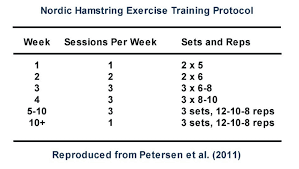
Understanding Hamstring Injuries
Muscle strains are categorized into three grades, with Grade III being the most severe, often requiring surgery. These injuries are common at the musculotendinous junction, where muscle transitions into tendon. The biomechanical vulnerability of hamstrings during high-speed activities makes them prone to injuries during sudden stops or changes in speed.
The Role of Nordic Curls in Injury Mitigation
Recent studies affirm the value of Nordic curls in reducing hamstring injuries. Systematic reviews have consistently shown that integrating these exercises into training regimens can halve the injury rates. This exercise enhances the eccentric strength of the hamstrings, crucial for decelerating the body during high-speed movements (British Journal of Sports Medicine) (The Chartered Society of Physiotherapy).
With a Nordstick, you can perform Nordic Curls almost anywhere!
Efficacy and Implementation Challenges
While the effectiveness of Nordic curls is supported by research, it's important to recognize that they are not a panacea. Their success depends on correct implementation, adherence to protocol, and individual differences in athletes’ baseline strength and conditioning.
Incorporating Nordic Curls into Training Programs
Nordic curls should be part of a comprehensive training strategy that includes a variety of exercises tailored to the athlete's needs. This approach should consider the volume and frequency of exercises, ensuring that all activities are performed with proper technique to maximize benefits and minimize risks.
Conclusion and Forward Look
Nordic curls are a valuable tool for reducing hamstring injury risks but should be integrated thoughtfully within broader injury prevention and training programs. Future research and adaptive training protocols will be essential in optimizing their use for athlete health and performance.
In summary, while Nordic curls significantly contribute to hamstring health, their integration into training programs requires careful consideration to ensure effectiveness and address individual athlete needs.
-
Wing, Chris MSc1; Bishop, Chris MSc2. Hamstring Strain Injuries: Incidence, Mechanisms, Risk Factors, and Training Recommendations. Strength and Conditioning Journal: June 2020 - Volume 42 - Issue 3 - p 40-57 doi: 10.1519/SSC.0000000000000538
-
Van Dyk N, Behan FP, Whiteley R. Including the Nordic hamstring exercise in injury prevention programmes halves the rate of hamstring injuries: a systematic review and meta-analysis of 8459 athletes. Br J Sports Med. 2019 Nov;53(21):1362-1370. doi: 10.1136/bjsports-2018-100045. Epub 2019 Feb 26. PMID: 30808663.
-
Al Attar WSA, Soomro N, Sinclair PJ, Pappas E, Sanders RH. Effect of Injury Prevention Programs that Include the Nordic Hamstring Exercise on Hamstring Injury Rates in Soccer Players: A Systematic Review and Meta-Analysis. Sports Med. 2017 May;47(5):907-916. doi: 10.1007/s40279-016-0638-2. PMID: 27752982.
-
Impellizzeri FM, McCall A, van Smeden M. Why methods matter in a meta-analysis: a reappraisal showed inconclusive injury preventive effect of Nordic hamstring exercise. J Clin Epidemiol. 2021 Dec;140:111-124. doi: 10.1016/j.jclinepi.2021.09.007. Epub 2021 Sep 11. PMID: 34520846.









































Leave a comment
This site is protected by hCaptcha and the hCaptcha Privacy Policy and Terms of Service apply.